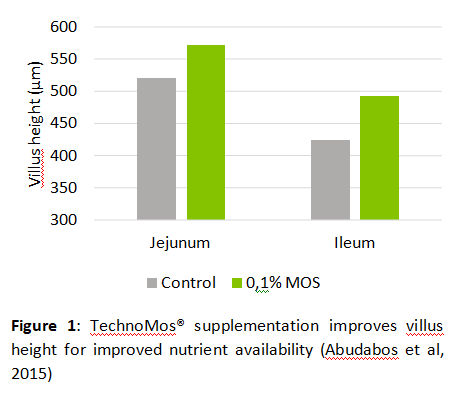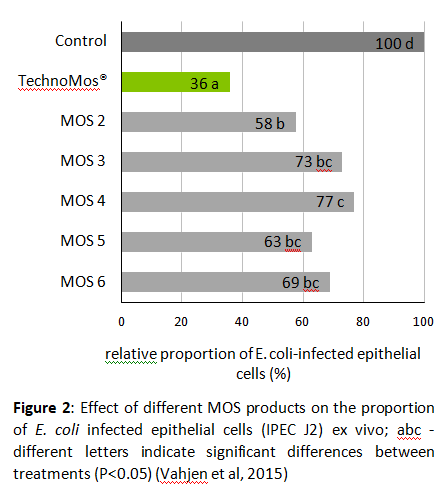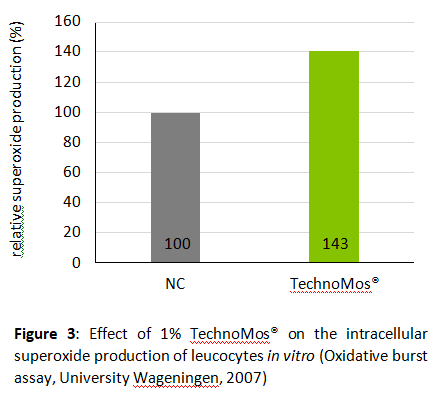Melanie Frisch, Regional Technical Manager IMEA
Biochem Zusatzstoffe Handels- und Produktionsgesellschaft mbH
One of the latest prebiotic definitions is “a selectively fermented ingredient that allows specific changes, both in the composition and/or activity in the gastrointestinal microbiota that confers benefits upon host well-being and health“ (Gibson, 2008). Prebiotics can positively affect the animal´s organism by stimulating the activity and growth of beneficial native bacteria (e.g., lactobacilli, bifidobacteria) in the gastrointestinal tract, by decreasing the pathogenic ones (e.g., salmonella, E. coli) and by stimulating the animal’s innate immunity. These aspects contribute to an overall improvement of performance. In times of increasing feed costs, these aspects become more important than ever.
Yeast based prebiotics are derived from the yeast cell wall of Saccharomyces cerevisiae. They are rich in mannan-oligosaccharides (MOS) and ß-1.3-1.6- glucans and are commonly referred to as MOS products.
Support of beneficial intestinal bacteria
The classical prebiotic effect of a MOS product is based on providing fermentable substrate that favors the proliferation of beneficial bacteria in the gut, resulting in more favorable profiles of fermentation products throughout the intestinal tract. In consequence, this ultimately leads to improved morphological parameters, a larger surface area for nutrient absorption, and improved gut integrity. In a trial performed with TechnoMos®, 42 day old broilers showed significantly longer villi in the ileum (figure 1).

Reduction of pathogens improves health status
Next to the before-mentioned prebiotic effect, yeast- based prebiotics with their MOS-components can agglutinate specific fimbriae of gram-negative bacteria like E. coli and salmonella (Borowsky et al., 2009; Vahjen et al., 2015). Thus, MOS helps to prevent the adhesion of these bacteria on the intestinal wall. Consequently, the growth of these bacteria in the gastro-intestinal tract is inhibited.
Due to high variations in yeast cell origin and production processes, respective differences in the efficacy of MOS products can be expected. Vahjen et al. (2015) tested the efficiency of different MOS- products on their capacity to reduce E. coli attachment on intestinal epithelial cells. After incubation of the epithelial cells in the cell culture plates to form a monolayer, the cells were treated with MOS suspensions (1%) of six different MOS products and infected with a fluorescent enterotoxic
E. coli K88 strain (ETEC K88). All MOS-products reduced E. coli attachment compared to control without MOS treatment but showed significant differences in their capacity to inhibit pathogen adhesion (Figure 2).

E. coli is the most frequently occurring bacterial pathogen in poultry production, leading to severe economic impacts and an increased number of antibiotic treatments. Using a high-quality MOS product is part of a successful strategy in securing the performance in E. coli affected flocks.
Strengthening the animals’ own defense
The β-1.3-1.6-glucans are known to have stimulating effects on the unspecific immune system by activating macrophages and increasing the production of cytokines, which are the initiator of the immune response. Thus, they can reinforce the natural defense against bacteria, viruses, and parasites.
One way to directly measure the effects on immune stimulation is the determination of intracellular superoxide production of leucocytes (figure 3). Further, TechnoMos® has demonstrated in several trials its ability to increase phagocytic activity and antibody titer, contributing to an overall improved immune competence of the animals.

A closer look on quality aspects
Numerous MOS-products are available on the market. But they differ in quality, especially in their pathogen binding activity. The more mannans are contained in the product, the stronger is the binding effect. Moreover, the starch content should be as low as possible to ensure a high purity. There are also differences in the yeast origin. The cell wall activity of a primary grown baker’s yeast is assumed to be advantageous in comparison to byproducts from beer/ethanol production. Another important characteristic is the particle size. Especially small particles extend the product surface and enable a higher binding capacity.
Conclusion
The use of a MOS product benefits animal health status due to three main modes of action:
• Improved intestinal microbiota and morphology
• Effective binding of pathogens
• Immune stimulation
However, it is essential to carefully assess the qualities of the individual MOS products. The mannan and ß-1.3-1.6 glucan content, the origin and purity as well as the particle size are critical to the effectiveness of a yeast cell wall product.
TechnoMos® is a premium product with a high content of active ingredients, high purity, and small particle size. It unifies the positive effects of mannan-oligosaccharides and ß-1.3-1.6-glucans and improves performance and health of your animals.